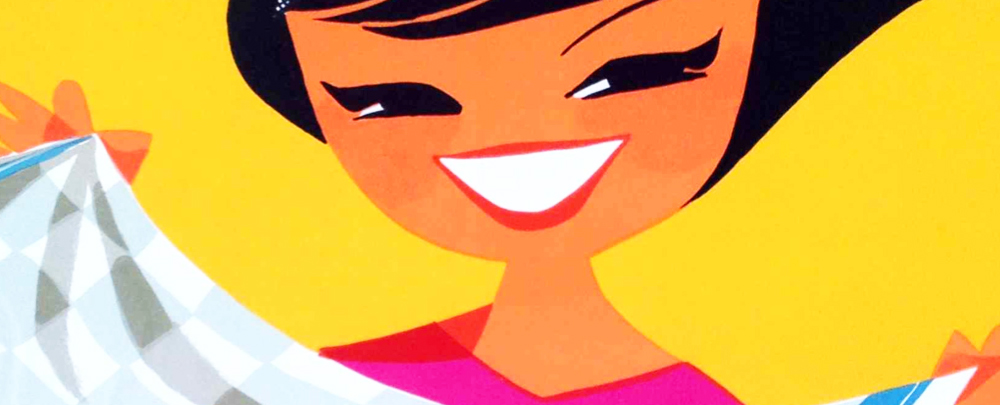How it was made
Design
Posters in Hungary, until about 1990, were designed almost exclusively by artists. Some were specialized in applied art and graphic design, and mostly designed posters, packaging, exhibitions, stamps, postcards, interior decoration, etc. Other artists worked as painters, sculptors, filmmakers, and designed posters. There were many great Hungarian poster artists, and you can find more information about them in our Artists section.
The process was not always easy, but in many cases, artists enjoyed tremendous artistic freedom. In all cases, there was a client, who commissioned a poster design. Before the Second World War, there were privately owned companies for their products and brands, larger and smaller stores, cities, event organizers, restaurants, bars and other venues, and the government or even religious organizations. Basically anyone.
Between 1949 and 1989, this was almost always the communist party, the government, cities, closely controlled organizations or a state-owned company.
The artist had to create original artworks, which are frequently called poster maquettes or original designs. In many cases they made multiple versions, either for themselves to develop different ideas, or if the client requested it. They used traditional techniques, and utilized painting, line drawing, photomontage, cutouts, and many other different ways to achieve the artistic and commercial quality that was required.
Usually they started out with sketches, then made really small compositional studies, and then made a larger maquette. If the artwork was accepted, the artists had to create a 1:1 version of the poster for the printing house, which meant making a 95 x 63 cm or 126 x 95 cm artwork, which was not an easy task in many cases, because weaker designs didn't work well when scaled up. This ended after the 1960s, when it turned out that printing houses no longer needed 1:1 maquettes.
Printing
Multiple different printing techniques were used to create posters in Hungary during the 20th century. Between the 1880s and the 1940s, lithography was used most frequently. There were also early offset techniques that were used from the 1920s. A lot of different printing techniques were used, as the industrly was rapidly developing. Intaglio was also used before WWII.
Stone lithography is a widely appreciated artistic printing process, because it gave the artists a lot of possibilities, and it is very close to small-scale printmaking by hand. It is a method of printing originally based on the immiscibility of oil and water. It utilizes a lithographic limestone with a smooth surface, first applying oil, fat, or wax onto the surface of a smooth, level lithographic limestone plate. The stone was treated with a mixture of acid and gum arabic, etching the portions of the stone that were not protected by the grease-based image. When the stone was subsequently moistened, these etched areas retained water; an oil-based ink could then be applied and would be repelled by the water, sticking only to the original drawing. The ink would finally be transferred to a blank paper sheet, producing a partial, single colour image of the poster. For each colour, a different stone was used, therefore each colour had to be printed very precisely to create the final mulit-coloured image.
There were numerous famous companies that printed Hungarian posters, including:
-
Athenaeum Rt. / Athenaeum Irodalmi és Nyomdai Rt. (1868 - 1956)
-
Bakács Albert Litográfia (1888 - 1948)
-
Bruchsteiner és Fia (1858 - 1946)
-
Czettel és Deutsch nyomda / Czettel, Deutsch és Társa nyomda (1851 - 1940)
-
Földes Sátori és Reményi (1919)
-
Franklin Társulat (1873 - 1982)
-
Globus Nyomda / Globus Rt. (1894 - 1948)
-
Grafikai Intézet (1923 - 1941)
-
Hamburger és Birkholz nyomda / Hamburger és Birkholz Papír és Nyomdaipari Rt. (1876 - 1948)
-
Hungária Hírlapnyomda Rt. (1869 - 1948)
-
Janina Rt. / Janina Cigarettapapírgyár Rt. Könyvnyomdája (1916 - 1948)
-
Kellner és Mohrlüder Rt. / Kellner és Mohrländer nyomda (1878 - 1929)
-
Klösz György és Fia (1867 - 1948)
-
Kultúra Rt. (1918 - 1924)
-
Kunossy Vilmos és Fia / Kunossy Grafikai Műintézet Rt. / Kunossy V. nyomda / Kunossy Vilmos nyomda / Kunossy Rt. (1856 - 1931)
-
Lengyel Lipót nyomda / Lengyel Lipót Könyvnyomdai Műintézet (1880 - 1902)
-
Lédrády Testvérek nyomdája (1867 - 1948)
-
Magyar Földrajzi Intézet Nyomdája / Földrajzi Intézet Rt. (1890 - 1948)
-
Piatnik Nándor és Fia nyomda / Magyar Grafikai Műhely / Piatnik Nándor és Fiai magyar játékkártyagyár Rt. nyomdája/ Első Magyar Játékkártyagyár Rt. (1903 - 1948)
-
Posner Károly Lajos nyomda (1852 - 1948)
-
Radó Jenő és Gyula kőnyomda (1900 - 1948)
-
Seidner Emil Plakát és Cimkegyár Könyvnyomdája (1903 - 1948)
-
Budapest Székesfőváros Házi Nyomda (1874 - 1948)
-
Thália Kultúra R.t. (1900 - 1930)
After WWII
After 1945, modern offset printing became the most widely used technique for poster printing in Hungary, and with it came new methods of the artistic work involved in creating posters. Lithography was still in use during the second half of the 1940s, but it rapidly disappeared after 1949-1950 when all the famous privately owned printing houses that resumed operating after the war has ended, were nationalized, their names changed, and many of them were closed.
From the 1960s, most posters were printed by the Offset Nyomda. Intaglio was used by the Egyetemi Nyomda (University Printing House).

Lengyel: Damask table cloth 1968 (detail)
Poster during these decades were mostly printed by:
-
Athenaeum Nyomda
-
Állami Nyomda
-
BKKM Mozi Rota Kecskemét / Kecskeméti Moziüzemi Vállalat Rotája
-
Egyetemi Nyomda
-
Fővárosi Nyomdaipari Vállalat
-
Globus Nyomda
-
Játékkártyagyár
-
Kartográfiai Vállalat
-
Nyomdakísérleti
-
Offset Nyomda
-
Pátria Nyomda
-
Plakát- és Címkenyomda
-
Ságvári Nyomda
-
Sylvester János Nyomda / Sylvester J. Nyomda
-
Szikra Nyomda / Pécsi Szikra Nyomda
-
Terv Nyomda
-
Zrínyi Nyomda (Formerly Légrády Testvérek)